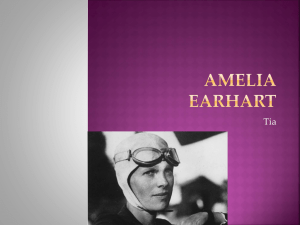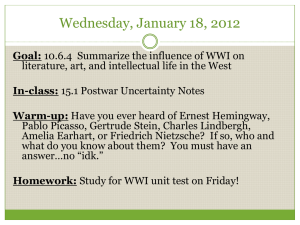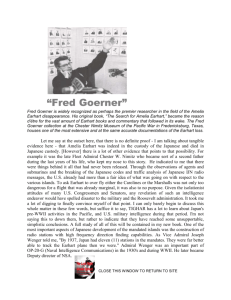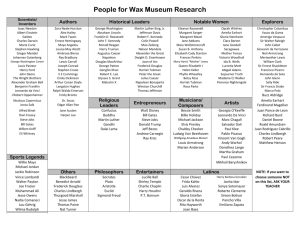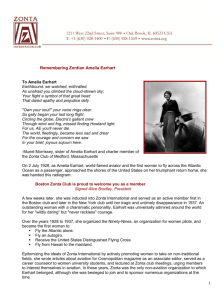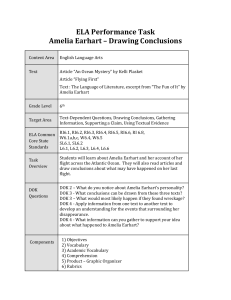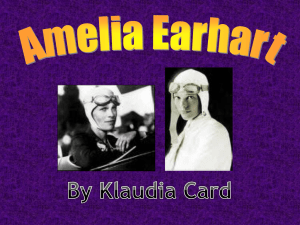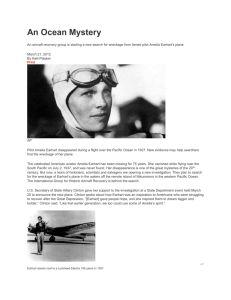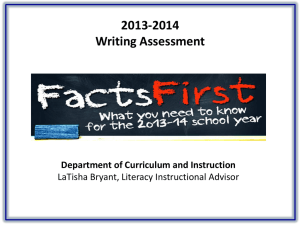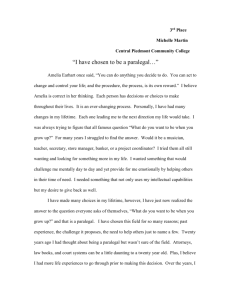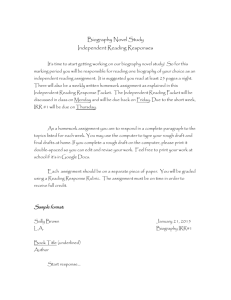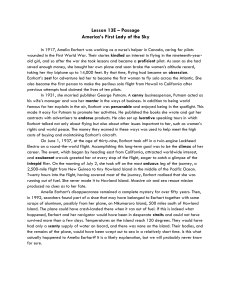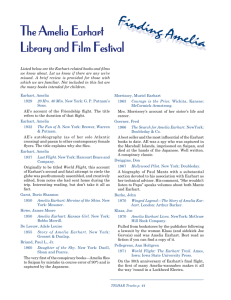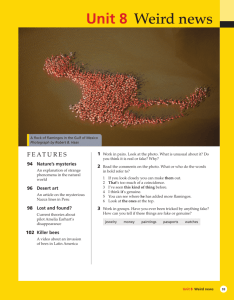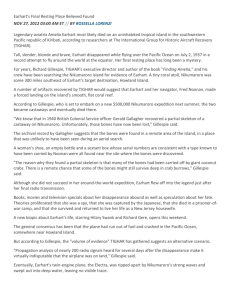Amelia Earhart: Young Air Pioneer
advertisement
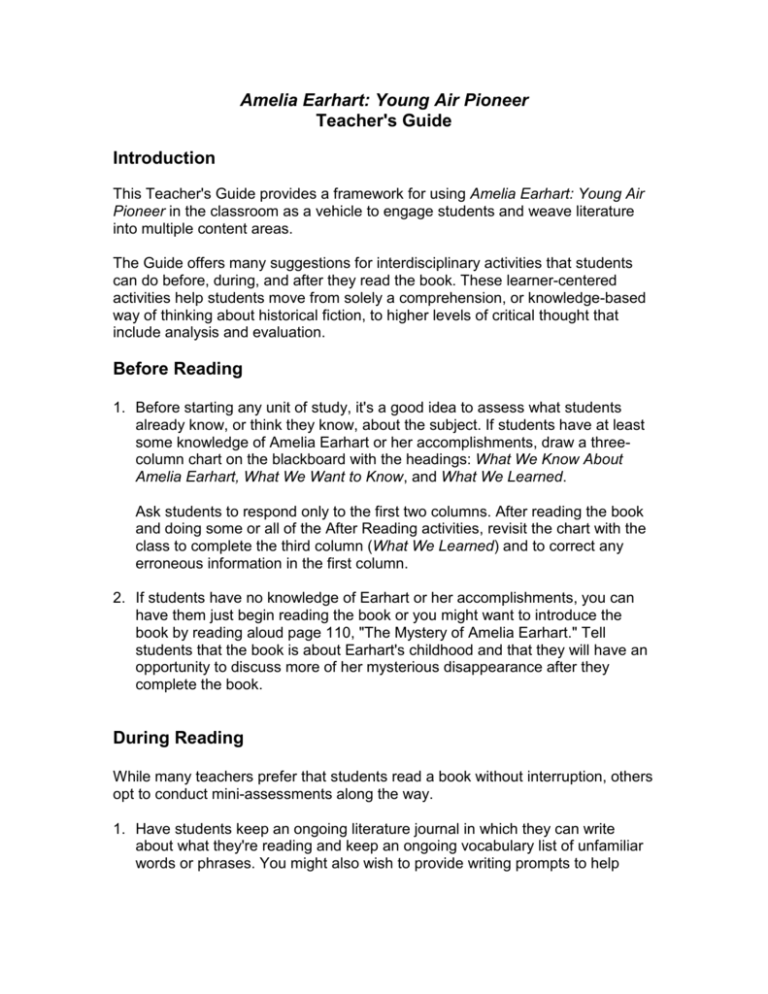
Amelia Earhart: Young Air Pioneer Teacher's Guide Introduction This Teacher's Guide provides a framework for using Amelia Earhart: Young Air Pioneer in the classroom as a vehicle to engage students and weave literature into multiple content areas. The Guide offers many suggestions for interdisciplinary activities that students can do before, during, and after they read the book. These learner-centered activities help students move from solely a comprehension, or knowledge-based way of thinking about historical fiction, to higher levels of critical thought that include analysis and evaluation. Before Reading 1. Before starting any unit of study, it's a good idea to assess what students already know, or think they know, about the subject. If students have at least some knowledge of Amelia Earhart or her accomplishments, draw a threecolumn chart on the blackboard with the headings: What We Know About Amelia Earhart, What We Want to Know, and What We Learned. Ask students to respond only to the first two columns. After reading the book and doing some or all of the After Reading activities, revisit the chart with the class to complete the third column (What We Learned) and to correct any erroneous information in the first column. 2. If students have no knowledge of Earhart or her accomplishments, you can have them just begin reading the book or you might want to introduce the book by reading aloud page 110, "The Mystery of Amelia Earhart." Tell students that the book is about Earhart's childhood and that they will have an opportunity to discuss more of her mysterious disappearance after they complete the book. During Reading While many teachers prefer that students read a book without interruption, others opt to conduct mini-assessments along the way. 1. Have students keep an ongoing literature journal in which they can write about what they're reading and keep an ongoing vocabulary list of unfamiliar words or phrases. You might also wish to provide writing prompts to help students think about what they're reading and to make connections to their own lives. Example of writing prompts: • What impact did Amelia's childhood experiences have on her life as an adult? How did they shape her views about life? What kinds of experiences have you had in your life that have shaped your views about things? • What are some of Amelia's qualities, or personality traits, that you think helped to shape who she became as an adult? (Students might identify such traits as bravery, being a pioneer, wanting to learn new things, having new ideas, and being determined to do things that girls were told they could not.) What are some of YOUR best qualities, or traits of which you are most proud? • On the "About the Author" page at the end of the book, Jane Moore Howe says she wanted "…to choose events that showed Amelia's courage." Did she? Give examples of how you think she did or didn't do this. 2. As students read the book, be sure to keep a world map posted so that they can identify each city, state, and country mentioned. 3. As they read, have students identify figures of speech (e.g., metaphors and similes), phrases of alliteration, analogies, and language of the time period. After Reading Historical fiction provides wonderful opportunities to weave and blend literature into many different content areas in meaningful ways. Following are a handful of ways for you to integrate a study of Amelia Earhart in your classroom. Although they are organized by content areas, we encourage you to move across content lines to blend them in natural ways AND to encourage your students to conduct further research on any specific topics of interest. Assessment: All of the activities can be assessed in traditional ways (i.e., with quizzes and letter grading systems) to determine how well students can memorize and can recount facts. However, since these activities are rooted in discovery, discussion, communication, and collaboration, they lend themselves to more holistic types of assessment that measure achievement of academic skills, behaviors, and even social/emotional growth. We encourage you to use one or more of the following alternative assessments as students complete the activities. • Portfolios—Keep one portfolio of work for each student to measure progress over a specific period of time. Portfolios are a great aid for both • • • • student/teacher and parent/teacher conferences. Encourage students to participate in selecting samples of writing, artwork, research notes, etc. to be included in their portfolios. Rubrics— Create a rubric, or chart (with or without grades or a numerical grading scale) to assess whether or not students have met specific standards and learning goals that you have previously identified. Self-Assessment—Hold regular teacher/student interviews to listen to students evaluate their own progress and skills. Peer-Assessment—Have students give and receive constructive feedback to assess such things as collaborative group work and to critique writing. Anecdotal Notes—As students work individually or in teams, make informal observations of how they solve problems, think critically, conduct research, work with others, and synthesize newly learned information. Add your notes to students' portfolios and share them during parent/teacher conferences. Language Arts Connections 1. Have students create cluster maps (graphic organizers) around such concepts as bravery, courage, or overcoming obstacles. Use cluster maps as jumping off points for literature response writing and class discussions. 2. Students can write their own theories about what they think happened to Amelia Earhart on her final journey. (See Social Studies Connections for related activities.) 3. Read Black Beauty aloud to the class, just as Amelia's mother read it to her. 4. Have students write radio scripts about Amelia's accomplishments or a radio script reporting her disappearance. Tape record and/or perform them for the class. 5. Interest in flight has been around for a long, long time! Have students read ancient Greek mythology that involves flight—specifically the myths of Pegasus, the flying horse, and of course Daedulus and Icarus, the father/son team who attempted to fly with wings of feathers and wax. Social Studies Connections 1. Have students work individually or in pairs to complete the WebQuest by following links to gather information about Earhart's life so that they can compile a class timeline. Encourage students to explore all parts of each site, reminding them to take careful notes about life events and important dates surrounding her contributions to aviation. When the WebQuests are complete, have students work together to create the class timeline to be hung around the walls of the classroom. The top portion of the timeline can include world events (listed by decade) and the bottom portion can include important events in Earhart's life. The timeline should encompass approximately 1890 to 1940. Be sure students include events described in the book as well as those they learn about from the Web sites. When the timeline is complete, have the class analyze it. What world events helped shaped Earhart's life? (For example, during World War I, she left college to volunteer at any army hospital and spent a lot of free time around planes.) How do world events today help shape our lives, or do they? 2. On a globe or world map, have students pinpoint all of the places mentioned by Earhart's teacher during their Geography lesson (Chapter 4). Extend the activity by mapping some of Earhart's famous flights. Be sure to identify the area near Howland Island where she disappeared. 3. Hold a class debate about Earhart's disappearance. Have teams of students research the major theories and argue for/against each. Encourage students to use the class timeline when considering their arguments. 4. Learn more about the history of stagecoaches and state fairs—both events that are described in the book. Science Connections 1. Have students conduct research to learn about other famous aviators and their contributions, including Charles Lindbergh, Amy Johnson, the Wright Brothers, Beryl Markham, Bessie Coleman, and Harriet Quimby. 2. November is Aviation History Month. Hold an aviation and flight-themed science fair. Encourage students to use the school library, public library, and Internet to find science experiment resources. Don't miss the K-8 Aeronautics Internet Textbook (http://wings.avkids.com) for wonderful explanations of all things aeronautical. 3. In Chapter 4, Earhart's father mentions that planes can fly even though they're heavier than air. Help students begin to understand the science behind flight. Start with simple aviation experiments that show Bernoulli's principle of lift and air movement. Have students hold a piece of paper with both hands, right under their lower lips. Ask them to blow across the top of the paper and observe what happens. Results: When blowing across the top of the paper, the air speeds up and can't press down on the paper as strongly. Therefore, the air pressure underneath the paper is now greater than the air pressure on top of the paper and the paper is lifted by the force of the air pressure beneath it. That force is called "lift." Airplanes use this same basic principle. As air moves over the surface of the wings, it moves faster than the air below the wings. This increases pressure and allows the plane to lift and fly. 4. In Chapter 6, at the State Fair, Amelia's father says that he doesn't think airplanes, will "…ever have any practical purpose, but they're a great scientific discovery." Ask students to predict inventions for the future of flight. Where will we be able to travel that we're not able to now? What might the vehicles look like? Students can write about their inventions, illustrate them, or make three-dimensional models. Mathematics Connections 1. After students make paper airplanes (see Arts Connections), have them measure the length of the classroom and then test-throw their planes. Measure the distance of each flight and graph the results. Older students might want to use a stopwatch to determine speed, using the formula Distance/ Time = Speed. Record and graph all data to determine which paper flies the farthest distance and which one at the fastest speed. 2. Identify coordinates, or areas on globes or maps using ordered pairs to describe degrees of latitude and longitude. You might wish to give students coordinates and ask them to identify the nearest continent or city using lines of latitude and longitude. Extend this activity by having students plan a trip around the world, including specific coordinates in their descriptions. 3. Have students calculate the number of time zones Earhart flew through on each of her most famous flights.. They will need to first look at time zone maps to know that there are 24 time zones on Earth. Extend the activity further by having students find the approximate number of degrees of latitude in each time zone. Arts Connections 1. Design paper airplanes (directions are available in many books and on many Web sites) from papers of different size and weight. Test fly them and record the results. (See Math Connections for more.) 2. Create a mural of an early airplane, identifying all parts (i.e., stick, rudder, instrument panel, wings, nose, cockpit, propeller) as described in Chapter 13. 3. Have students sketch examples of things in nature that fly (e.g., seeds, birds, insects). 4. Write an original play based on the book and perform it for students in younger classes. Copyright 2002, Patria Press, Inc.
